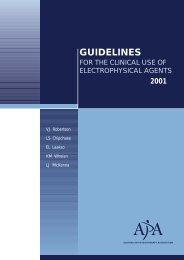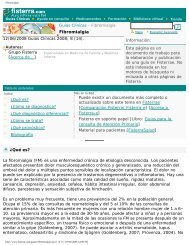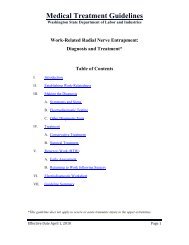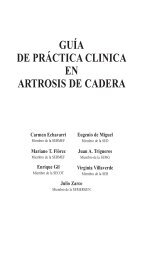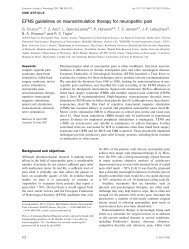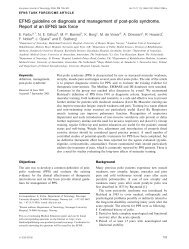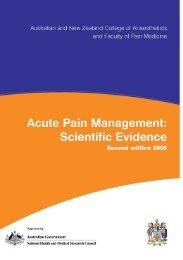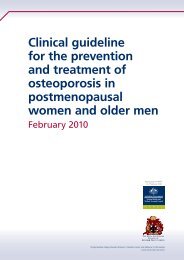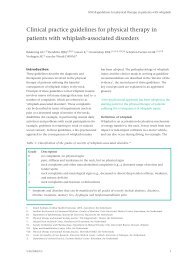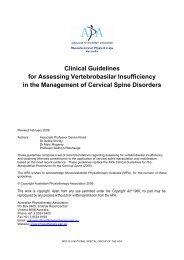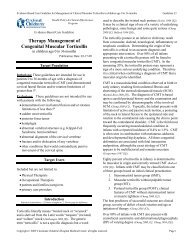Practice Parameter and Literature Review of the Usefulness of ...
Practice Parameter and Literature Review of the Usefulness of ...
Practice Parameter and Literature Review of the Usefulness of ...
You also want an ePaper? Increase the reach of your titles
YUMPU automatically turns print PDFs into web optimized ePapers that Google loves.
<strong>Practice</strong> <strong>Parameter</strong>: Carpal Tunnel Syndromefrom 25 control subjects <strong>and</strong> 20 h<strong>and</strong>s from 13 patients with mildCTS were evaluated. The motor <strong>and</strong> sensory NCV across <strong>the</strong> carpaltunnel were more likely to be abnormal than conventional DSLs <strong>and</strong>DMLs determined from <strong>the</strong> wrist.129. Kimura J. Collision technique. Physiologic block <strong>of</strong> nerve impulses instudies <strong>of</strong> motor nerve conduction velocity. Neurology 1976;26:680-682. Background Reference. Source: Kimura 1978.130. Kimura J. The carpal tunnel syndrome: Localization <strong>of</strong> conductionabnormalities within <strong>the</strong> distal segment <strong>of</strong> <strong>the</strong> median nerve. Brain1979;102:619-635. Criteria Met (6/6: 1,2,3,4,5,6) Source: Shurr,1986. Abstract: With stimulation at <strong>the</strong> wrist <strong>and</strong> palm, orthodromicSNAPs were recorded over <strong>the</strong> index finger <strong>and</strong> median CMAP from<strong>the</strong> wrist to APB were recorded from 122 h<strong>and</strong>s from 61 normalsubjects <strong>and</strong> 172 h<strong>and</strong>s from 105 CTS patients. Sixty-one percent <strong>of</strong><strong>the</strong> median CMAPs were abnormal, 63% <strong>of</strong> <strong>the</strong> wrist-to-fingerlatencies were abnormal <strong>and</strong> 81% <strong>of</strong> <strong>the</strong> wrist to palm latencies wereabnormal. They also reported cases where l cm inching stimulationacross <strong>the</strong> carpal tunnel was abnormal in patients with o<strong>the</strong>rwisenormal studies.131. Kimura I, Ayyar DR. The carpal tunnel syndrome:Electrophysiological aspects <strong>of</strong> 639 symptomatic extremities.Electromyogr Clin Neurophysiol 1985;25:151-164. Criteria Met (4/6:1,2,3,5) Source: Mortier, 1988. Abstract: The following techniqueswere studied: (a) with stimulation at <strong>the</strong> elbow, wrist <strong>and</strong> mid-palm,orthodromic DSL were determined to <strong>the</strong> index finger, (b) DMLswere determined to <strong>the</strong> APB after stimulation at <strong>the</strong> wrist <strong>and</strong> elbow,<strong>and</strong> (c) electro-myography in 639 symptomatic h<strong>and</strong>s from 438 CTSpatients <strong>and</strong> 175 extremities <strong>of</strong> 148 normal subjects. There was arelative slowing <strong>of</strong> <strong>the</strong> sensory NCV across <strong>the</strong> carpal tunnel ascompared to <strong>the</strong> forearm in 100% <strong>of</strong> <strong>the</strong> patients with CTS. This wasmore sensitive than <strong>the</strong> median DSL <strong>and</strong> DML. Forty percent <strong>of</strong> <strong>the</strong>patients had abnormalities on needle EMG with 21.7% havingpositive sharp waves or fibrillations.132. Kimura J, Murphy MJ, Varda DJ. Electrophysiological study <strong>of</strong>anomalous innervation <strong>of</strong> intrinsic h<strong>and</strong> muscles. Arch Neurol1976;33:842-844. Background Reference. Source: Gutmann, 1986.133. *Kopell HP, Goodgold J. Clinical <strong>and</strong> electrodiagnostic features <strong>of</strong>carpal tunnel syndrome. Arch Phys Med Rehabil 1968;49:371-376.Criteria Met (2/6: 1,2) Source: Louis, 1987.134. Koskimies K, Farkkila M, Pyykko I, Jantti V, Aatola S, Starck J,Inaba R. Carpal tunnel syndrome in vibration disease. Br J Ind Med1990;47:411-416. Criteria Met (2/6: 1,3) Source: Medline Search.135. Kothari MJ, Rutkove SB, Caress JB, Hinchey J, Logigian EL, PrestonDC. Comparison <strong>of</strong> digital sensory studies in patients with carpaltunnel syndrome. Muscle Nerve 1995;18:1272-1276. Criteria Met(5/6: 1,3,4,5,6) Source: Medline Search. Abstract: Prospective studyto evaluate <strong>the</strong> relative sensitivity <strong>of</strong> antidromic sensory studies <strong>of</strong> <strong>the</strong>four median innervated digits in 59 patients with CTS diagnosed on<strong>the</strong> basis <strong>of</strong> a combination <strong>of</strong> clinical <strong>and</strong> median NCS abnormalities.The conduction distance was 10 cm for D1 <strong>and</strong> 13 cm for D2-D4. Thereference population <strong>of</strong> 30 was composed <strong>of</strong> healthy volunteers orpatients with lower extremity radiculopathies. In <strong>the</strong> 26 CTS patientswith a normal DML to APB, digit 1 was abnormal in 81%, digit 2 in42%, digit 3 in 54%, <strong>and</strong> digit 4 in 38%. In <strong>the</strong> 33 CTS patients with aprolonged DML, digit 1 was abnormal in 94%, digit 2 in 88%, digit 3in 91%, <strong>and</strong> digit 4 in 88%. We conclude that in CTS patients with anormal DML to <strong>the</strong> APB, digit 1 is <strong>the</strong> most sensitive in identifyingfocal slowing <strong>of</strong> sensory conduction across <strong>the</strong> wrist. However, inCTS patients with a prolonged DML, <strong>the</strong> sensitivity <strong>of</strong> sensoryconduction is not significantly different among <strong>the</strong> four digits.136. *Kouyoumdjian JA, Morita Mda P. Comparison <strong>of</strong> nerve conductiontechniques in 95 mild carpal tunnel syndrome h<strong>and</strong>s. ArqNeuropsiquiatr 1999;57:195-197.Criteria Met (3/6: 1,3,4). Source:Medline Search. Abstract: Prospective study <strong>of</strong> 5 NCS techniques inpatients suspected <strong>of</strong> CTS <strong>and</strong> selected for <strong>the</strong> study at least one <strong>of</strong><strong>the</strong> 5 studies was abnormal: (1) wrist-index finger onset latency(WIF), abnormal ≥ 2.8 ms, 14 cm; (2) palm-wrist onset latency (PW),abnormal ≥ 1.8 ms, 8 cm; (3) comparison median/ulnar palm-wristonset latency (CPW), abnormal ≥ 0.4 ms; (4) comparison <strong>of</strong>median/ulnar onset latency, wrist-ring finger (CMU), abnormal ≥ 0.5ms, 14 cm; (5) comparison <strong>of</strong> median/radial onset latency, wristthumb(CMR), abnormal ≥ 0.4 ms, 10 cm. All 95 CTS h<strong>and</strong>s selectedhave <strong>the</strong> WIF ≤ 3.5 ms to identify “mild CTS.” We found <strong>the</strong> CMR(97.8%) technique <strong>the</strong> most sensitive for mild CTS electrodiagnosis<strong>and</strong> <strong>the</strong> only comparative method with all potentials recordable whencompared to CPW (88.4%), PW (84.2%), CMU (72.6%) <strong>and</strong> WIF(68.4%).137. Kraft GH, Halvorson GA. Median nerve residual latency: Normalvalue <strong>and</strong> use in diagnosis <strong>of</strong> carpal tunnel syndrome. Arch Phys MedRehabil 1983;64:221-226. Criteria Met (4/6: 1,3,5,6) Source:Bleecker, 1987. Abstract: With stimulation at <strong>the</strong> elbow <strong>and</strong> wrist <strong>and</strong>recording over <strong>the</strong> ABP, DMLs <strong>and</strong> forearm NCVs were determinedin 100 normal subjects <strong>and</strong> 3 CTS patients. The residual latency(DML–distance between stimulation <strong>and</strong> recording electrodes inmm/forearm NCV in m/s). They present 3 cases where <strong>the</strong> residuallatency was <strong>the</strong> only abnormality found.138. Kremer M, Gilliatt RW, Golding JSR, Wilson TG. Acroparaes<strong>the</strong>siaein carpal tunnel syndrome. Lancet 1953;2:590-595. BackgroundReference. Source: Phalen 1966.139. Kuhlman KA, Hennessey WJ. Sensitivity <strong>and</strong> specificity <strong>of</strong> carpaltunnel syndrome signs. Am J Phys Med Rehabil 1997;76:451-457.Background Reference. Source: Medline Search. Abstract: Thesensitivity <strong>and</strong> specificity <strong>of</strong> six CTS signs were determined byevaluating 143 subjects (228 h<strong>and</strong>s) with symptoms <strong>of</strong> CTS.Immediately after performing <strong>the</strong> six physical examination tests,st<strong>and</strong>ard nerve conduction studies were performed on all 228 h<strong>and</strong>s todetermine <strong>the</strong> presence or absence <strong>of</strong> CTS. CTS was present in 142h<strong>and</strong>s <strong>and</strong> absent in 86 h<strong>and</strong>s. The signs were not very sensitive (23-69%), but were fairly specific (66-87%) for CTS. A square-shapedwrist <strong>and</strong> abductor pollicis brevis weakness were <strong>the</strong> most sensitivesigns (69 <strong>and</strong> 66%, respectively), <strong>and</strong> are recommended as part <strong>of</strong> <strong>the</strong>examination <strong>of</strong> CTS. Median nerve hypes<strong>the</strong>sia <strong>and</strong> <strong>the</strong> Phalen signboth have fair sensitivity (51%) but good specificity (85 <strong>and</strong> 76%,respectively). The median nerve compression sign <strong>and</strong> <strong>the</strong> H<strong>of</strong>fmann-Tinel sign both have poor sensitivity (28 <strong>and</strong> 23%, respectively), <strong>and</strong>thus are less helpful in evaluating subjects with suspected CTS.140. Kuntzer T. Carpal tunnel syndrome in 100 patients: sensitivity,specificity <strong>of</strong> multi-neurophysiological procedures <strong>and</strong> estimation <strong>of</strong>axonal loss <strong>of</strong> motor, sensory <strong>and</strong> sympa<strong>the</strong>tic median nerve fibers. JNeurol Sci 1994;127:221-229. Criteria Met (6/6: 1,2,3,4,5,6) Source:Medline Search. Abstract: Study <strong>of</strong> 70 control subjects <strong>and</strong> <strong>of</strong> <strong>the</strong>more symptomatic h<strong>and</strong>s <strong>of</strong> 100 CTS patients diagnosedindependently by clinical history <strong>and</strong> examination. Study specificallydesigned to meet all six AAEM criteria for evaluation <strong>of</strong> usefulness <strong>of</strong>NCS to diagnose CTS including continuous monitoring <strong>of</strong> h<strong>and</strong>temperature during <strong>the</strong> NCS. Reports <strong>the</strong> criteria for abnormalities,sensitivities <strong>and</strong> specificities <strong>of</strong> 19 sensory, motor <strong>and</strong> autonomicparameters. 9/19 parameters reached a specificity <strong>of</strong> 97%. At least 1/9<strong>of</strong> <strong>the</strong> parameters was abnormal in 87% <strong>of</strong> <strong>the</strong> CTS patients.Abnormal median CMAP <strong>and</strong> SNAP amplitudes <strong>and</strong> abnormalmedian F-wave parameters were not as sensitive or specific todiagnose CTS as abnormal median sensory <strong>and</strong> motor carpal tunnelsegment conduction velocities. Of median nerve conduction velocitiesin <strong>the</strong> carpal tunnel segments, <strong>the</strong> sensory studies were morefrequently abnormal than <strong>the</strong> motor studies.141. Lambert EH. Diagnostic value <strong>of</strong> electrical stimulation <strong>of</strong> motornerves. Electroencephalogr Clin Neurophysiol 1962;22(suppl):9-16.Background Reference. Source: Kimura 1985.142. Laroy V, Spaans F, Reulen J. Nerve conduction studies show noexclusive ulnar or median innervation <strong>of</strong> <strong>the</strong> ring finger. ClinNeurophysiol 1999;110:1492-1497. Criteria Met (2/6: 1,3) Source:Medline Search. Abstract: Combination <strong>of</strong> retrospective study <strong>of</strong>1617 h<strong>and</strong>s <strong>of</strong> 1000 patients <strong>and</strong> prospective study <strong>of</strong> 430 h<strong>and</strong>s in260 patients referred for electrodiagnostic evaluation <strong>of</strong> brachialgia(not defined in paper). No case <strong>of</strong> mononeural innervation <strong>of</strong> D4 by<strong>the</strong> median or ulnar nerve was encountered. In all cases in which D4SNAPs were obtained with both median <strong>and</strong> ulnar stimulation, itcould be demonstrated that <strong>the</strong> SNAPs were not due to co-stimulationby simultaneous recording <strong>of</strong> SNAPs from ano<strong>the</strong>r median or ulnarinnervated finger. The authors discuss <strong>the</strong> reasons why some previousclinical <strong>and</strong> experimental studies may have mistakenly concluded thatmononeural innervation <strong>of</strong> D4 occurs as a physiological variation.Finally, comparison <strong>of</strong> SNAP parameters in 183 h<strong>and</strong>s with increasedmedian nerve distal latencies showed conduction to be more impairedin <strong>the</strong> fibers innervating D4 than in those supplying D3.143. Lauritzen M, Liguori R, Trojaborg W. Orthodromic sensoryMuscle & Nerve Supplement X 2002 S967



